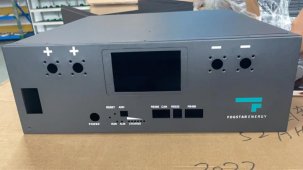Ben@Fogstar
Solar Enthusiast
- Joined
- Aug 25, 2022
- Messages
- 45
Hello,
It's my first time posting here, we run a small business in the UK - but have offices and warehousing in China (www.fogstar.co.uk). We have several customers on this forum and thank you if you have purchased prismatic cells from us in the past.
We're looking to design a rack-mounted 48v 100Ah battery - however, we've come to a point where there are design specifications that we'd like feedback on. We'd like to ask all you knowledgeable folk what you'd like to see as a consumer. We're extremely honest, and like to tell our customers everything about what's inside of each rack - something we believe is missing from most retailer websites.
Cells
Some of these cells have been selected due to the size of the rack we are trying to create (3U) - most Chinese racks are using Gotion grade B cells - and quoting something like 7000+cycles. This is simply not true, however, they are extremely cheap.
EVE 100LA Grade A
Pace
The general consensus in China is that PACE makes the best BMS for storage batteries (found in Jakiper Batteries). They've been established longer than JBD, however, they don't have much of a following. 5 inverter protocols can be programmed into each Pace BMS - however a new version of the pace BMS will soon be able to handle 10 inverter protocols.
Any other BMS suggestions? Seplos? (although I think pace make this) JK?
I think the EVE LA with a JBD BMS is the best solution. Cells we really believe in, with a BMS that seems to be tried and tested.
Let me know your thoughts, happy to upload spec sheets of each cell if it helps
Thanks,
Ben
Fogstar
It's my first time posting here, we run a small business in the UK - but have offices and warehousing in China (www.fogstar.co.uk). We have several customers on this forum and thank you if you have purchased prismatic cells from us in the past.
We're looking to design a rack-mounted 48v 100Ah battery - however, we've come to a point where there are design specifications that we'd like feedback on. We'd like to ask all you knowledgeable folk what you'd like to see as a consumer. We're extremely honest, and like to tell our customers everything about what's inside of each rack - something we believe is missing from most retailer websites.
Cells
Some of these cells have been selected due to the size of the rack we are trying to create (3U) - most Chinese racks are using Gotion grade B cells - and quoting something like 7000+cycles. This is simply not true, however, they are extremely cheap.
EVE 100LA Grade A
- 100Ah
- Will fit in a 3U system
- Good cycle life
- Good relationship with Eve
- Expensive
- 100Ah
- Will fit in a 3U system
- Average cycle life
- No pre-existing relationship
- Cheaper
- Most racks using this cell
- 100Ah
- Will fit in a 3U system
- Bad cycle life
- No pre-existing relationship
- Cheapest
Pace
The general consensus in China is that PACE makes the best BMS for storage batteries (found in Jakiper Batteries). They've been established longer than JBD, however, they don't have much of a following. 5 inverter protocols can be programmed into each Pace BMS - however a new version of the pace BMS will soon be able to handle 10 inverter protocols.
- Expensive
- 5 Inverter Protocols (10 soon)
- Lack of APP. but we could make one
- Windows Software
- Less of a following and community projects
- More Reliable (?)
- Inexpensive
- 5 Inverter Protocols
- App
- Windows Software
- Popular, with community projects
- Less reliable (?)
Any other BMS suggestions? Seplos? (although I think pace make this) JK?
I think the EVE LA with a JBD BMS is the best solution. Cells we really believe in, with a BMS that seems to be tried and tested.
Let me know your thoughts, happy to upload spec sheets of each cell if it helps
Thanks,
Ben
Fogstar






